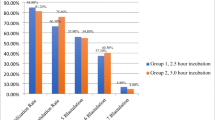Abstract
Purpose
Total fertilisation failure (TFF), even with intracytoplasmic sperm injection (ICSI), occurs in approximately 3 % of cycles, can be recurrent and the exact cause is difficult to elucidate. Differentiation between oocyte and sperm-related cause of TFF is possible using mouse oocyte-activation techniques, but is not an option within most clinical settings. Therefore, the management of these couples is clinically driven, and the endpoint, if recurrent, is often the use of donor gametes. However, with the invariable lack of a definitive cause of TFF, any decision between the use of donor sperm or oocytes remains an emotive one. We present two case reports demonstrating the importance of appropriate investigation, activation techniques (mechanical and chemical) and clinical management options to develop a clinical algorithm prior to the use of donor gametes.
Methods
This study is composed of two case reports of assisted reproduction investigation and treatment within an assisted conception unit for couples with recurrent total fertilisation failure.
Results
Using appropriate investigation (endocrine, urological and embryological) and treatments (ICSI, IMSI, oocyte-activation techniques), a fertilisation rate of 48 % was achieved in two cycles in couples following a total of nine previous cycles (and 200 previously collected eggs) with TFF.
Conclusions
Oocyte activation requires the triggering of intracellular calcium oscillations by the release of a sperm-specific factor (phospholipase C zeta (PLCζ)) into the oocyte cytoplasm. Although, PLCζ deficiencies have been demonstrated as putative causes of failed activation, impaired oocyte responsiveness may also be a factor. The use of donor gametes is often recommended and is often the required endpoint of treatment. However, these reports outline a clinical algorithm that potentially offers success without donation, and also offers a systematic approach to help decide whether donor oocytes or sperm should be recommended.

Similar content being viewed by others
References
Palermo G, Joris H, Devroey P, Van Steirteghem AC. Pregnancies after intracytoplasmic injection of single spermatozoon into an oocyte. Lancet. 1992;340(8810):17–8.
Esfandiari N, Javed MH, Gotlieb L, Casper RF. Complete failed fertilization after intracytoplasmic sperm injection—analysis of 10 years’ data. Int J Fertil Womens Med. 2005;50(4):187–92.
Saunders CM, Larman MG, Parrington J, Cox LJ, Royse J, Blayney LM, et al. PLC zeta: a sperm-specific trigger of Ca(2+) oscillations in eggs and embryo development. Dev Camb Engl. 2002;129(15):3533–44.
Heytens E, Parrington J, Coward K, Young C, Lambrecht S, Yoon S-Y, et al. Reduced amounts and abnormal forms of phospholipase C zeta (PLCzeta) in spermatozoa from infertile men. Hum Reprod Oxf Engl. 2009;24(10):2417–28.
Ajduk A, Małagocki A, Maleszewski M. Cytoplasmic maturation of mammalian oocytes: development of a mechanism responsible for sperm-induced Ca2+ oscillations. Reprod Biol. 2008;8(1):3–22.
Neri QV, Lee B, Rosenwaks Z, Machaca K, Palermo GD. Understanding fertilization through intracytoplasmic sperm injection (ICSI). Cell Calcium. 2014;55(1):24–37.
Rybouchkin A, Dozortsev D, Pelinck MJ, De Sutter P, Dhont M. Analysis of the oocyte activating capacity and chromosomal complement of round-headed human spermatozoa by their injection into mouse oocytes. Hum Reprod Oxf Engl. 1996;11(10):2170–5.
HFEA - Code of Practice 8th Edition. 2009
Tesarik J, Rienzi L, Ubaldi F, Mendoza C, Greco E. Use of a modified intracytoplasmic sperm injection technique to overcome sperm-borne and oocyte-borne oocyte activation failures. Fertil Steril. 2002;78(3):619–24.
Bartoov B, Berkovitz A, Eltes F, Kogosovsky A, Yagoda A, Lederman H, et al. Pregnancy rates are higher with intracytoplasmic morphologically selected sperm injection than with conventional intracytoplasmic injection. Fertil Steril. 2003;80(6):1413–9.
Ebner T, Moser M, Sommergruber M, Jesacher K, Tews G. Complete oocyte activation failure after ICSI can be overcome by a modified injection technique. Hum Reprod Oxf Engl. 2004;19(8):1837–41.
Ozil J-P, Banrezes B, Tóth S, Pan H, Schultz RM. Ca2+ oscillatory pattern in fertilized mouse eggs affects gene expression and development to term. Dev Biol. 2006;300(2):534–44.
Vanden Meerschaut F, D’Haeseleer H, Roeyers H, Oostra A, Van Lierde K, De Sutter P. Neonatal and developmental outcome of children born following assisted oocyte activation (AOA). Fertil Steril. 2012;98:S16.
Benchaib M, Lornage J, Mazoyer C, Lejeune H, Salle B, François GJ. Sperm deoxyribonucleic acid fragmentation as a prognostic indicator of assisted reproductive technology outcome. Fertil Steril. 2007;87(1):93–100.
Bernardini L, Borini A, Preti S, Conte N, Flamigni C, Capitanio GL, et al. Study of aneuploidy in normal and abnormal germ cells from semen of fertile and infertile men. Hum Reprod Oxf Engl. 1998;13(12):3406–13.
Lopes S, Jurisicova A, Casper RF. Gamete-specific DNA fragmentation in unfertilized human oocytes after intracytoplasmic sperm injection. Hum Reprod Oxf Engl. 1998;13(3):703–8.
Setti AS, Paes de Almeida Ferreira Braga D, Iaconelli A, Aoki T, Borges E. Twelve years of MSOME and IMSI: a review. Reprod Biomed Online. 2013;27(4):338–52.
Kashir J, Sermondade N, Sifer C, Oo SL, Jones C, Mounce G, et al. Motile sperm organelle morphology evaluation-selected globozoospermic human sperm with an acrosomal bud exhibits novel patterns and higher levels of phospholipase C zeta. Hum Reprod Oxf Engl. 2012;27(11):3150–60.
Armstrong S, Vail A, Mastenbroek S, Jordan V, Farquhar C. Time-lapse in the IVF-lab: how should we assess potential benefit? Hum Reprod Oxf Engl. 2015;30(1):3–8.
Tesarik J, Sousa M, Testart J. Human oocyte activation after intracytoplasmic sperm injection. Hum Reprod Oxf Engl. 1994;9(3):511–8.
Author information
Authors and Affiliations
Corresponding author
Additional information
Capsule
Case reports to develop an algorithm to highlight the importance of oocyte-activation techniques and investigation prior to the use of donor gametes.
Rights and permissions
About this article
Cite this article
Nicopoullos, J.D.M., Whitney, E., Wells, V. et al. Case reports to suggest an algorithm for management of total fertilisation failure prior to use of donor gametes. J Assist Reprod Genet 32, 1679–1684 (2015). https://doi.org/10.1007/s10815-015-0564-5
Received:
Accepted:
Published:
Issue Date:
DOI: https://doi.org/10.1007/s10815-015-0564-5



